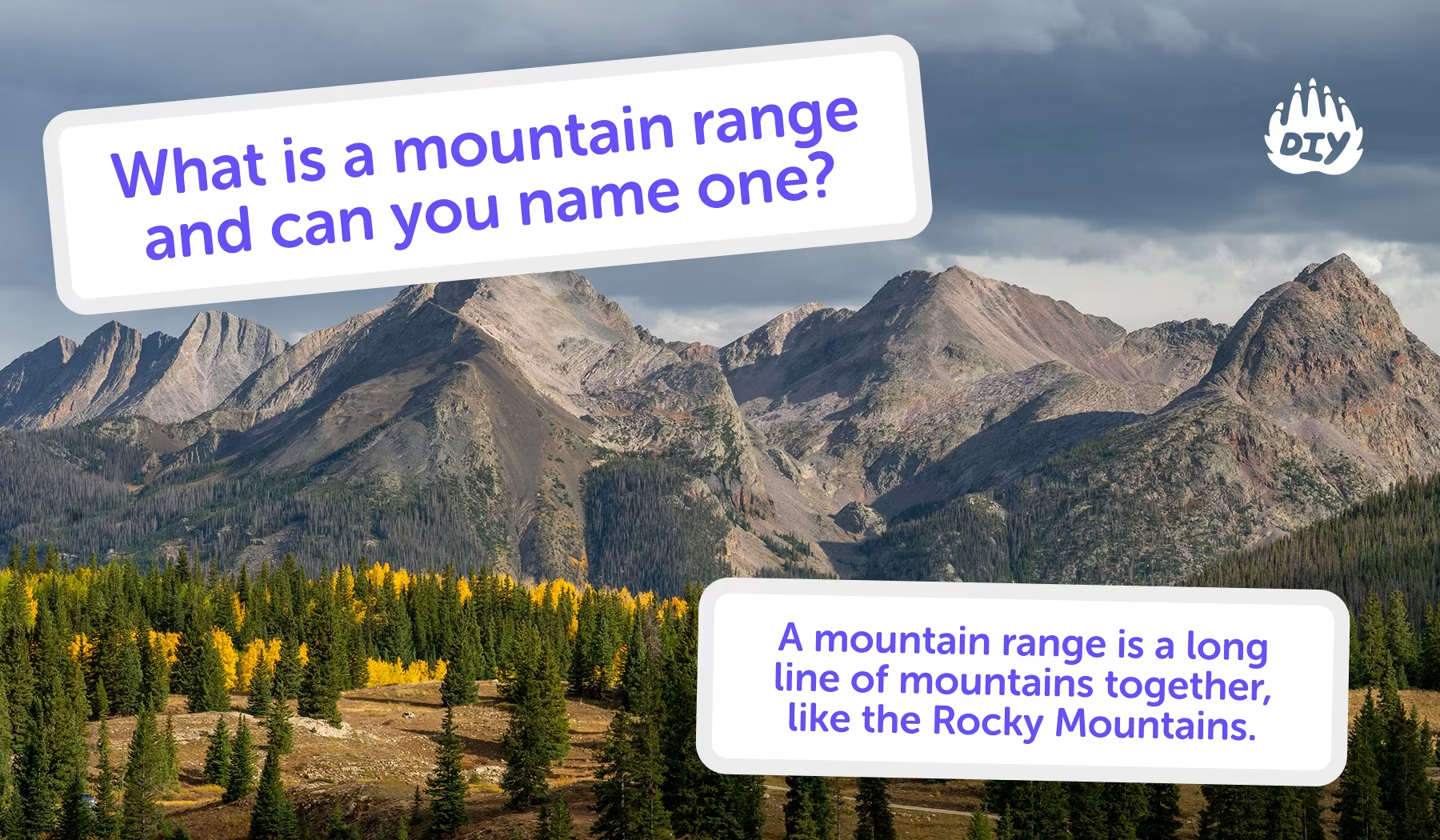Why Kids Learn About Mountains
Kids often get homework questions like: What is a mountain range? Can you name one? Answering these helps them connect geography to real-world landmarks.
If your child needs extra help, the AI Homework Helper explains concepts step by step, quizzes them safely, and keeps learning fun.

What Is a Mountain Range?
A mountain range is a chain or group of mountains linked by high ground. Instead of one tall peak, it’s many summits and valleys connected across a region—or even an entire continent.
How mountain ranges form
Plate tectonics: When Earth’s plates push together, the crust crumples and lifts, creating long belts of mountains.
Volcanoes: Repeated eruptions can build peaks that line up into a range.
Erosion and uplift: Wind, rain, glaciers, and rivers carve sharp ridges and deep valleys while slow uplift keeps raising the land.
Mountain ranges shape weather, feed rivers, create habitats for plants and animals, and influence where people live and travel. Understanding them connects geology with geography, climate, and history.
Famous Mountain Ranges Around the World
The Himalayas (Asia)
Home to Mount Everest, the world’s tallest peak at 29,032 feet (8,849 meters).
Stretch across Nepal, India, China, Bhutan, and Pakistan.
Still rising today as tectonic plates push together.
The Andes (South America)
The longest mountain range on Earth, stretching 4,300 miles.
Runs through seven countries, including Chile, Peru, and Argentina.
Home to Machu Picchu, an ancient Incan city.
The Rockies (North America)
Stretch from Canada through the U.S. to New Mexico.
Famous for national parks like Yellowstone and Glacier.
Rich in wildlife: bears, elk, mountain lions.
The Alps (Europe)
Cross France, Switzerland, Italy, and Austria.
Known for skiing, climbing, and villages like Zermatt.
Includes Mont Blanc, the tallest peak in Western Europe.
👉 Ask the DIY.org homework helper tool: “What are the five most famous mountain ranges in the world?”
How Mountain Ranges Affect People
Weather: Mountains block winds, create rain shadows, and change local climates.
Water supply: Many rivers start in mountains (like the Ganges from the Himalayas).
Culture: Mountain ranges shape music, food, and traditions of local people.
Adventure: Skiing, climbing, and hiking all rely on mountains.
Everyday Connections for Kids
Mountains aren’t just faraway places, they affect daily life:
Snow from mountains fills rivers that provide drinking water.
Weather patterns in your city may depend on nearby ranges.
Vacation spots often include mountains for camping or skiing.
Fun Facts About Mountains
The Himalayas are still growing about 1 inch per year.
The Andes are visible from space because of their length.
The Rockies inspired songs, poems, and artwork in the U.S.
Mount Kilimanjaro in Africa is a single peak, not a range, but it’s one of the most famous.
👉 Try asking the AI Homework Helper: “Why are the Himalayas still growing?”
Tips for Parents Helping With Geography Homework
Show maps: Point out ranges on a globe or atlas.
Use comparisons: Explain that the Andes are longer than the distance from New York to Los Angeles and back again.
Make it real: If you’ve visited mountains, show photos and tell stories.
Use AI tools: The Homework Helper can quiz your child on where ranges are located.
Questions about mountain ranges
What is a mountain range in simple terms?
A group of mountains connected together.
What’s the largest mountain range?
The Andes, the longest in the world.
Which range has the tallest mountain?
The Himalayas, home to Mount Everest.
Are mountains still growing?
Yes, some (like the Himalayas) are getting taller as plates move.
Do all countries have mountain ranges?
No, some countries are mostly flat, but many have at least small ranges.
What’s the difference between a mountain and a volcano?
A volcano is a type of mountain formed by eruptions, while not all mountains are volcanic.
How Mountain Chains Change Everything
A mountain range is more than just tall peaks it’s a chain of natural wonders that shape landscapes, weather, and human life. From the towering Himalayas to the rugged Rockies, these ranges show how powerful Earth’s forces are.
For kids, learning about mountain ranges connects geography to history, culture, and nature. And with the DIY.org homework helper tool, they can safely dive deeper, ask questions, and build confidence in schoolwork.



